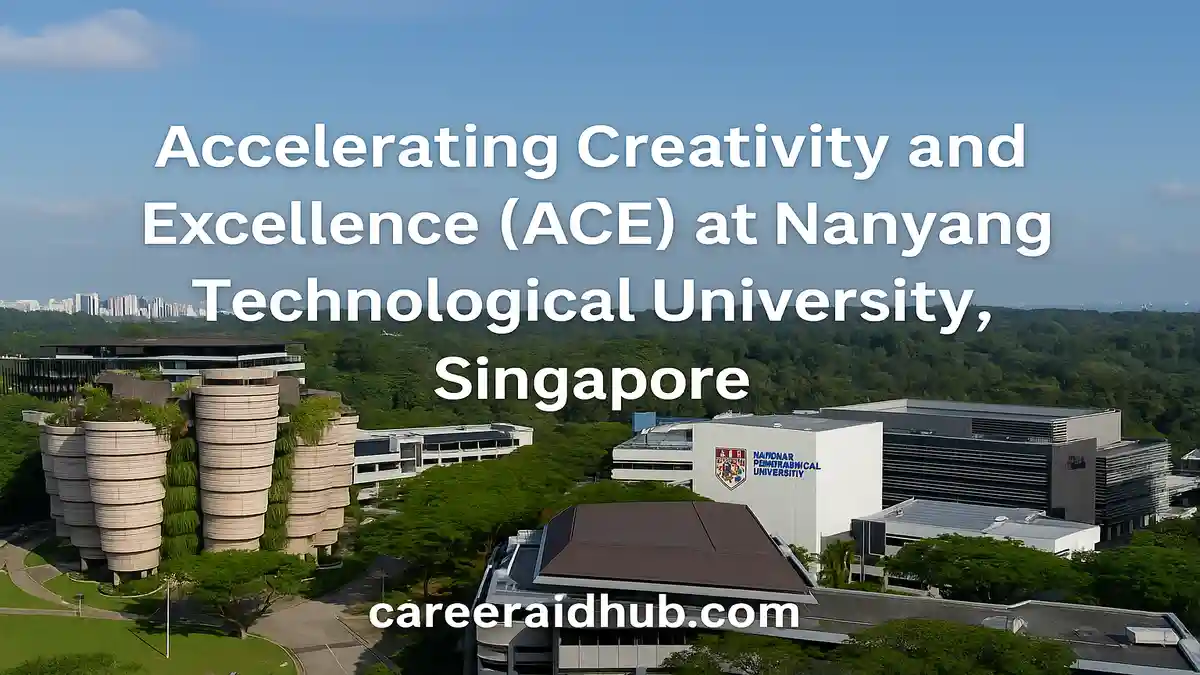Nanyang Technological University (NTU), Singapore, operates an internal research funding scheme called Accelerating Creativity and Excellence (ACE) to support bold, unconventional and cross-disciplinary research ideas. This NTU ACE funding programme functions as a catalytic seed fund, giving researchers time, resources, and intellectual freedom to test high-risk, high-reward concepts that can later mature into major national or international grants.
Accelerating Creativity and Excellence (ACE) at Nanyang Technological University, Singapore, is an internal seed funding programme that enables NTU faculty teams to pursue bold, cross-disciplinary research, test high-risk, high-reward ideas, and build strong foundations for large competitive grants and impactful collaborations with industry, government, and society in Singapore and globally.
What Is the ACE Programme?
A Seed Funding Scheme for High-Risk, High-Reward Research at NTU
At its core, the NTU ACE programme aims to spark bold, creative and unconventional ideas at the intersections of research disciplines. The scheme was created to nurture early-stage concepts that may struggle to secure traditional research funding because they are exploratory, disruptive, or highly interdisciplinary.
Instead of setting narrow thematic calls, ACE focuses on the quality, originality, and ambition of the proposed research ideas. Projects supported under this scheme
-
- Make an original contribution to existing knowledge or professional practice
- Pioneer a novel methodology, technology, or design approach
- Offer a creative solution to a real-world challenge, whether scientific, technological, social, environmental, or cultural
By doing this, the ACE internal grant at NTU encourages research teams to rethink disciplinary boundaries, connect methods from distant fields, and open new trajectories for long-term impact and external funding.
Who Can Apply for ACE Funding?
Broad Eligibility with a Strong Interdisciplinary Requirement
One of the key strengths of the ACE internal funding scheme is its inclusive eligibility. The call is open to all NTU faculty members, from early-career academics in their first appointments to senior professors who lead established research groups.
However, there is one crucial structural condition that shapes every ACE proposal:
Each ACE project must include participating faculty from at least two different Colleges and/or research institutes within NTU.
This requirement ensures that funded projects are genuinely cross-disciplinary rather than single-discipline projects with nominal co-investigators. It also encourages researchers to move beyond familiar collaborations and build new partnerships across:
-
- Engineering and physical sciences
- Humanities, arts, and social sciences
- Business, education,and communication
- Medicine, life sciences, and environmental studies
For early-career researchers, joining or leading an NTU ACE cross-disciplinary project can be an effective way to build a diverse professional network and demonstrate the ability to work across disciplinary lines, which many external funders now value.
Funding Amount and Project Duration
What the NTU ACE Seed Funding Provides in Practical Terms
The ACE scheme offers substantial internal seed funding to help transform promising ideas into credible pilot results:
-
- Award size: up to S$200,000 per project
- Project duration: up to 24 months
With this level of support, research teams can:
-
- Recruit research staff such as research fellows, officers, or graduate students
- Acquire specialised equipment, datasets, or software tools
- Conduct pilot experiments, fieldwork, prototyping, or design iterations
- Organise internal workshops, stakeholder consultations, or outreach activities
Because the funding period is clearly defined, teams are encouraged to work strategically and efficiently, focusing on high-value deliverables that will position them strongly for competitive external funding once the ACE project concludes. This makes the ACE scheme a powerful stepping stone toward larger national or international grants.
Application Timeline and Process
Regular Calls and a Structured Proposal Pathway
The ACE internal funding scheme follows a twice-yearly call cycle. NTU usually launches calls for ACE proposals around
A typical ACE application journey includes the following stages:
-
- Identify a cross-disciplinary problem
Researchers first articulate a question or challenge that clearly requires contributions from more than one discipline. This step often grows from informal conversations, existing collaborations, or gaps identified in previous projects. - Build a complementary team
Next, faculty members form a project team that brings together distinct yet complementary expertise from at least two Colleges or research institutes. Teams may include methodologists, domain specialists, designers, data scientists, or policy experts, depending on the problem. - Prepare a concise, rigorous proposal
The project leader then prepares a structured proposal, usually based on an official template. The document should clearly explain:- The core research question and why it matters now
- The innovative or unconventional aspects of the idea or methodology
- The respective roles of each collaborator and how the disciplines will integrate
- A realistic two-year workplan, key milestones, and a justified budget
- Submit via the ACE application channel
Finally, the completed proposal is submitted through the route specified by NTU, commonly an official application form sent to the ACE programme email or an internal online portal.
- Identify a cross-disciplinary problem
Because calls are recurring, researchers who are not ready for one round can refine
How Are ACE Proposals Evaluated?
Selection Criteria and Expectations for NTU ACE Projects
A dedicated Selection Committee reviews all ACE proposals. The committee evaluates applications based on scholarly merit, feasibility, and strategic alignment with NTU’s research priorities. Three overarching criteria guide the assessment:
-
- Originality
Reviewers look for projects that challenge existing paradigms, open new avenues of inquiry, or combine tools and theories in distinctive ways. Simple incremental extensions of existing work are less likely to succeed in this internal competition. - Importance
Proposals must explain the potential significance of the project. If successful, will the research substantially advance knowledge, inform policy, change professional practice, or lead to new technologies, products, or creative works? - Relevance and Fit
The committee also considers whether the project aligns with NTU’s broader research directions and whether the chosen team is appropriately skilled and positioned to deliver the work.
- Originality
Beyond these headline criteria, the committee checks that each ACE proposal:
-
- Contains authentic cross-disciplinary content, not token collaboration
- Presents a feasible, well-sequenced workplan for the 24-month period
- Identifies a plausible pathway to impact, such as follow-on grants, partnerships, or translation activities
Projects that skilfully balance ambition and realism, and clearly show how ACE funding will unlock new directions, usually stand out in this internal NTU scheme.
Examples of ACE-Funded Research
Illustrative Cross-Disciplinary Projects and Thematic Breadth
The portfolio of ACE-funded projects shows how widely the scheme reaches across NTU’s research landscape. Selected examples illustrate the diversity of themes, disciplines, and methods supported by this internal NTU research funding:
-
- Fashion, materials science, and computing – Teams have explored wearable designs that integrate smart materials, sensors, and AI-driven customisation, redefining sustainability and personalisation in clothing.
- Digital coaching for experiential learning – Researchers have developed intelligent platforms that use artificial intelligence and learning analytics to guide students through complex laboratory or field experiences.
- Biodiversity and conservation science – Collaborations between ecologists and engineers have used advanced sensing systems and robotics to track seeds, animals, and environmental change in tropical ecosystems.
- Cancer genomics and data science – Multidisciplinary groups have applied machine learning to epigenomic and transcriptomic datasets to understand alternative splicing and tumour behaviour.
- Plastics, circular economy, and behavioural change – Projects have examined biodegradation mechanisms inspired by plastic-eating organisms and created virtual-reality storytelling tools to influence recycling behaviour among youth.
These examples highlight how the ACE NTU funding programme fosters risk-taking at disciplinary interfaces, allowing teams to prototype ideas that may later attract competitive external support from national councils, international agencies, or industry partners.
Why ACE Matters for Researchers at NTU
Strategic Value for Individual Academic Careers and the University
For NTU academics, an ACE award is often more than a one-time internal grant. It usually becomes a launchpad for new research trajectories and a visible signal of institutional confidence in a researcher’s vision.
Winning ACE funding can help you:
-
- Demonstrate the ability to secure competitive internal research funding at NTU
- Build a track record in managing cross-disciplinary projects, a capability increasingly demanded by international funders
- Generate preliminary data, prototypes, or case studies needed for larger national and international grant applications
- Align your work with global agendas, such as the Sustainable Development Goals, by tackling problems that matter to society and industry
For NTU as a whole, the ACE programme supports a pipeline of innovative projects that strengthen the university’s research profile, attract external partners, and contribute to Singapore’s reputation as a hub for cutting-edge, impact-oriented science, technology, and scholarship.
Practical Tips for a Competitive ACE Proposal
From Research Concept to Compelling NTU ACE Submission
When preparing an ACE proposal, consider the following practical strategies to strengthen your application for this internal NTU funding scheme:
-
Start with a Sharp, Cross-Cutting Question
Begin by articulating a precise question or challenge that genuinely demands expertise from multiple disciplines. A well-crafted problem statement helps reviewers immediately see why a cross-disciplinary approach is necessary and why ACE is the right mechanism to support it.
-
Build a Genuinely Integrated Team
Choose collaborators who bring distinct skills, methods, or perspectives, and describe clearly how these elements will interact in the project. Avoid superficial partnerships; instead, design work packages that require close collaboration between team members from different Colleges or institutes.
-
Emphasise Methodological and Conceptual Innovation
Show how your project advances the state of the art. You might propose a new experimental setup, a hybrid theoretical framework, a novel data pipeline, or an unconventional combination of design, engineering, and social science methods. Highlight why the ACE seed funding is essential for de-risking this innovation.
-
Map Out Tangible Outcomes in 24 Months
Define concrete outputs that are realistic within the project duration. These may include joint publications, demonstrator prototypes, curated datasets, policy briefs, creative works, or workshop series that establish a new community of practice at NTU. Make sure each outcome connects clearly to your research question.
-
Show Pathways to Scale, Impact, and Future Funding
Finally, outline how you will leverage ACE results after the project ends. Mention potential national funding agencies, international programmes, philanthropic sources, or industry partners you intend to approach, and explain why your ACE project will position you strongly for those opportunities.
As you develop your broader research communication strategy, you can also create internal links to complementary content on your site, such as a guide to internal research grant writing or a Singapore research fellowships overview, to help readers navigate related resources.
Conclusion
The Accelerating Creativity and Excellence (ACE) programme at Nanyang Technological University is a strategic internal investment mechanism that empowers faculty to pursue daring, cross-disciplinary research ideas with clear potential for real-world impact. By providing up to S$200,000 for projects lasting up to 24 months, insisting on collaboration across Colleges and institutes, and rewarding originality and significance, ACE strengthens both individual academic careers and NTU’s global research footprint.
Quick Facts: NTU ACE Internal Funding at a Glance
|
Feature |
Details |
|
Program Name |
Accelerating Creativity and Excellence (ACE) |
|
Host Country |
|
|
Funded By |
Nanyang Technological University (NTU) |
|
Duration |
Up to 24 months per project |
|
Study Mode |
Full-time research conducted at NTU |
|
Eligibility |
Open to all NTU faculty; each team must span at least two Colleges and/or research institutes |
|
Financial Support |
Up to S$200,000 per project |
|
Fields of Study |
All disciplines, with strong emphasis on cross-disciplinary collaborations |
|
Deadline |
Two calls per year, typically around April and October; exact dates for the next cycles will appear on the NTU site and will be updated soon |
|
Official Website |
Frequently Asked Questions (FAQs)
The ACE programme at NTU provides internal seed funding for bold, cross-disciplinary research projects that test high-risk, high-reward ideas and build foundations for future major grants.
ACE funding is open to all NTU faculty members, but each proposal must include investigators from at least two different Colleges or research institutes within the university.
The ACE scheme usually supports each selected project with up to S$200,000 in seed funding, allowing teams to hire staff, run pilot studies, and purchase essential research resources.
ACE-funded projects generally run for up to 24 months, giving research teams enough time to design, implement, and evaluate pilot work before applying for larger external grants.
Yes, strong ACE proposals usually outline how preliminary results will support future applications to national, international, or industry funding schemes, ensuring the work can scale beyond the seed phase.
Cross-disciplinary collaboration is central to ACE. Reviewers expect genuine integration of expertise from at least two Colleges or institutes, not just nominal co-investigators on the proposal.
Early-career researchers can use ACE to lead cross-disciplinary teams, gain grant management experience, generate data, and strengthen their funding track record.










